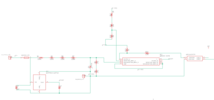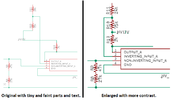I want to use 1kV to provide 10mA 20V, for which I would use a resistor voltage divider network.
However, there is a continuous leakage to ground in parallel. Is there a way to fix this leakage but still provide 20V to my system? That leakage would take 2 times more power handling on the resistors.
Doubtlessly, I would use a LDO to keep the 20V stable. I did not provide many details because I thought there could be a way exclusively to avoid leakage in a voltage divider.
Greatly appreciate any ideas!
However, there is a continuous leakage to ground in parallel. Is there a way to fix this leakage but still provide 20V to my system? That leakage would take 2 times more power handling on the resistors.
Doubtlessly, I would use a LDO to keep the 20V stable. I did not provide many details because I thought there could be a way exclusively to avoid leakage in a voltage divider.
Greatly appreciate any ideas!





